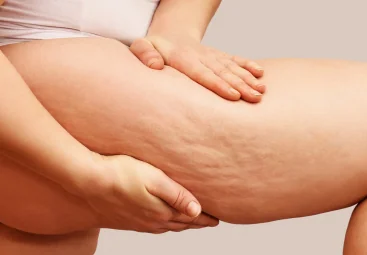In our community, we understand how confusing and frustrating it can be to deal with body changes, especially when it comes to conditions like Lipedema and cellulite. These two are often mixed up because they can look similar, but they are very different. Let’s dive into how you can tell them apart, what’s happening at a cellular level, and common mistakes that even health practitioners sometimes make.

How They Look
Lipedema usually shows up in the lower body—your thighs, buttocks, and sometimes your arms. It causes a symmetrical and disproportionate buildup of fat, making your legs and arms look column-like. These areas often feel painful and bruise easily, and the skin might be softer and cooler than the rest of your body. Sadly, Lipedema can get worse over time, leading to more discomfort and even making it hard to move around.
Cellulite, however, is more about appearance than pain. It looks like dimpled or "orange-peel" skin and is common on the thighs, buttocks, and abdomen. While it affects both men and women, it’s more common in women. The skin feels lumpy or bumpy but usually isn’t painful unless it’s very severe. The severity of cellulite can change with weight fluctuations but doesn’t generally get worse over time like Lipedema.
What's Happening Under the Skin
Lipedema involves an abnormal buildup of fat cells that stubbornly resist diet and exercise. These enlarged fat cells cause inflammation and thickening of the connective tissue, and your lymphatic system might struggle as it is compromised, leading to fluid retention and swelling.
In the case of cellulite, it’s about normal fat cells pushing against your connective tissue bands, creating that dimpled look. The connective tissue bands get stiff, pulling the skin down and causing the dimpling. Usually, your lymphatic system isn’t affected by cellulite, the condition is caused by the herniation of subcutaneous fat into the dermis, which creates a dimpled appearance. The structural changes in cellulite are related to fibrous septae pulling the skin down, but these changes do not typically involve lymphatic dysfunction or fluid retention.
Common Diagnostic Mistakes
Unfortunately, Lipedema is often mistaken for general obesity, leading to treatment plans focused only on weight loss, which don’t help much. Because of the visual similarities, health practitioners might also confuse cellulite with Lipedema, causing unnecessary worry and inappropriate treatments. Key symptoms like pain and easy bruising, which are major signs of Lipedema, might be overlooked, delaying the correct diagnosis and treatment.
If you suspect you have Lipedema, it's important to see a specialist who knows about the condition to get an accurate diagnosis and a tailored treatment plan. While lifestyle changes can help with cellulite, Lipedema might require specific medical interventions like liposuction designed for Lipedema and conservative treatments such as compression garments amongst others.

Managing these conditions effectively often requires specialized clothing. For instance, our ACTIVE leggings provide compression that helps with reduced swelling, minimized appearance of cellulite, improved blood circulation, support for your lymphatic system, and a slimming effect on your figure. These leggings are great for managing both symptoms of cellulite and lipedema.
We hope this helps you understand the differences between Lipedema and cellulite. By knowing what sets these conditions apart, you can better manage your health and seek the right treatments. If you have any concerns or questions, don’t hesitate to reach out to us. We’re here to support you every step of the way.
Join our LipedemaHeroes community over on Facebook and follow us on Instagram @lipoelastic_usa.
References:
Childs, D.R. and Murad, M.H. (2017). Lipedema: Diagnostic and Management Challenges. International Journal of Obesity, 41(2), pp. 240-243. Available at: https://www.nature.com/articles/ijo2016186 [Accessed 16 July 2024].
Herbst, K.L. (2012). Lipedema and Dercum’s Disease: Women With Pain and Fat. Endocrinology and Metabolism Clinics of North America, 41(2), pp. 441-447. Available at: https://www.ncbi.nlm.nih.gov/pmc/articles/PMC3523140/ [Accessed 16 July 2024].
Fife, C.E., Maus, E.A. and Carter, M.J. (2010). Lipedema: A Frequently Misdiagnosed and Misunderstood Fatty Deposition Syndrome. Advances in Skin & Wound Care, 23(2), pp. 81-92. Available at: https://journals.lww.com/aswcjournal/Fulltext/2010/02000/Lipedema__A_Frequently_Misdiagnosed_and.8.aspx [Accessed 16 July 2024].
Todd, M. (2023). Understanding Cellulite: Causes, Symptoms, and Treatment Options. [online] Healthline. Available at: https://www.healthline.com/health/cellulite [Accessed 16 July 2024].
Harwood, C.A. (2021). Lipedema: A Long-Overlooked Disease. British Journal of Dermatology, 184(4), pp. 639-648. Available at: https://onlinelibrary.wiley.com/doi/10.1111/bjd.19715 [Accessed 16 July 2024].
Rhoades, D. and Coelho, J.C.U. (2020). The Role of Connective Tissue in the Pathogenesis of Cellulite. Plastic and Reconstructive Surgery, 145(2), pp. 640-647. Available at: https://journals.lww.com/plasreconsurg/Fulltext/2020/02000/The_Role_of_Connective_Tissue_in_the_Pathogenesis.21.aspx [Accessed 16 July 2024].

 LIPOELASTIC TEAM
LIPOELASTIC TEAM 




